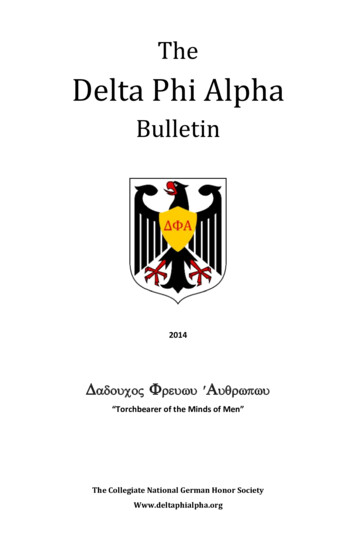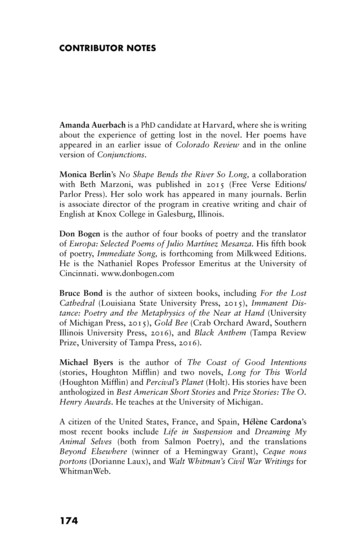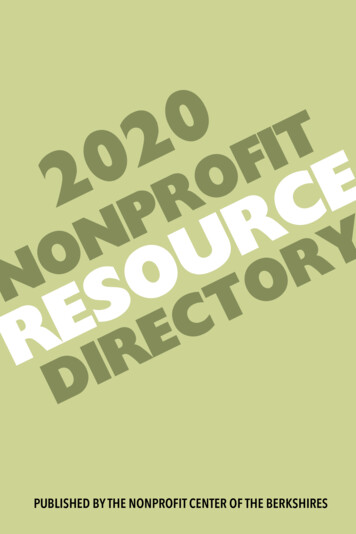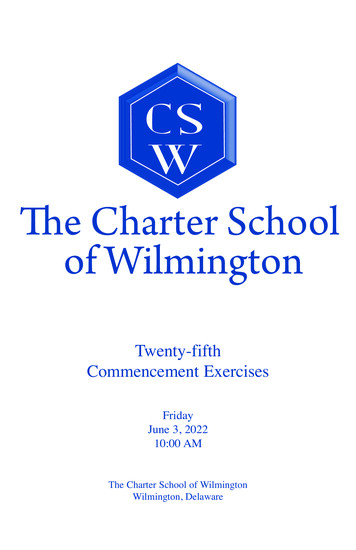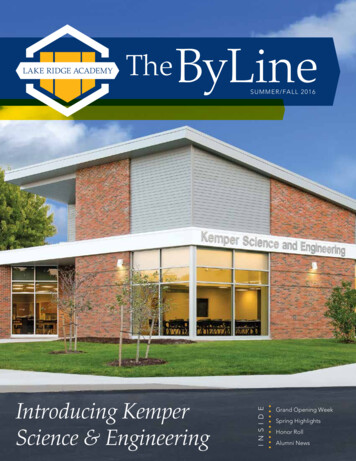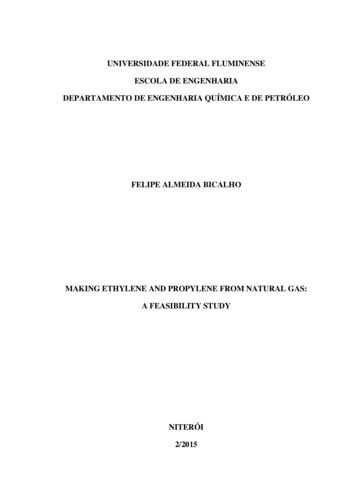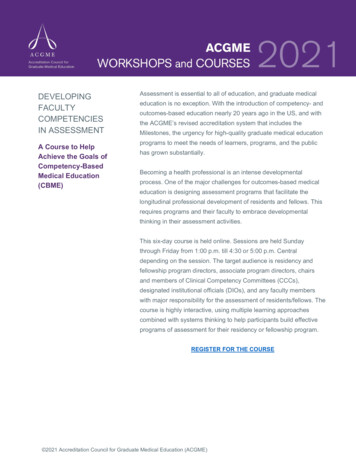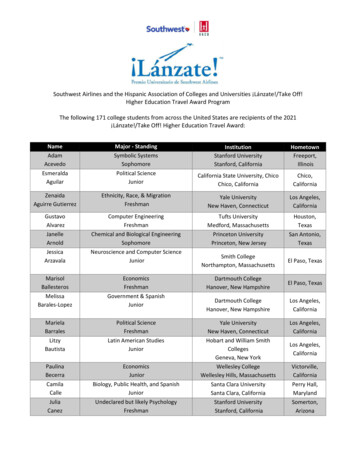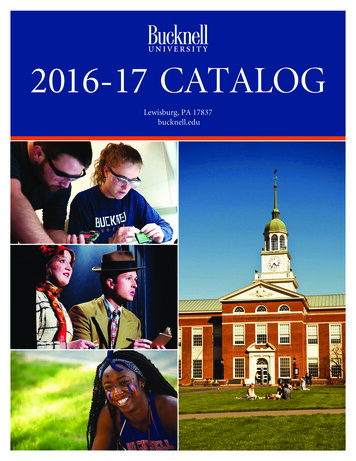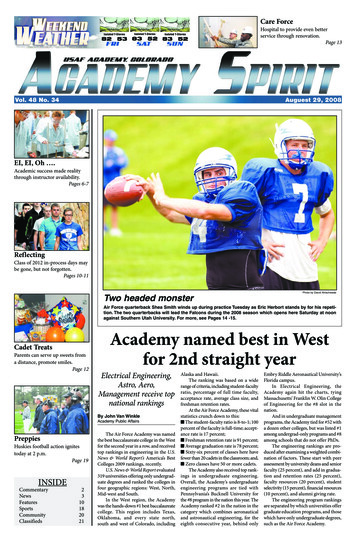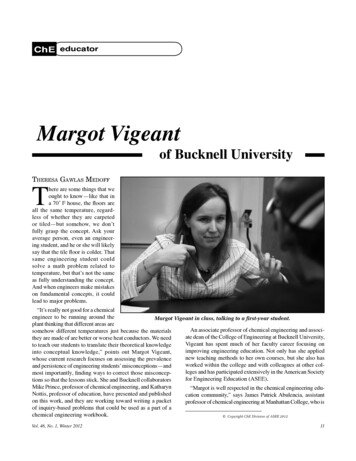
Transcription
ChE educatorMargot Vigeantof Bucknell UniversityTTheresa Gawlas Medoffhere are some things that weought to know—like that ina 70 F house, the floors areall the same temperature, regardless of whether they are carpetedor tiled—but somehow, we don’tfully grasp the concept. Ask youraverage person, even an engineering student, and he or she will likelysay that the tile floor is colder. Thatsame engineering student couldsolve a math problem related totemperature, but that’s not the sameas fully understanding the concept.And when engineers make mistakeson fundamental concepts, it couldlead to major problems.“It’s really not good for a chemicalengineer to be running around theMargot Vigeant in class, talking to a first-year student.plant thinking that different areas areAn associate professor of chemical engineering and associsomehow different temperatures just because the materialsate dean of the College of Engineering at Bucknell University,they are made of are better or worse heat conductors. We needVigeant has spent much of her faculty career focusing onto teach our students to translate their theoretical knowledgeimproving engineering education. Not only has she appliedinto conceptual knowledge,” points out Margot Vigeant,new teaching methods to her own courses, but she also haswhose current research focuses on assessing the prevalenceworked within the college and with colleagues at other coland persistence of engineering students’ misconceptions—andleges and has participated extensively in the American Societymost importantly, finding ways to correct those misconcepfor Engineering Education (ASEE).tions so that the lessons stick. She and Bucknell collaboratorsMike Prince, professor of chemical engineering, and Katharyn“Margot is well respected in the chemical engineering eduNottis, professor of education, have presented and publishedcation community,” says James Patrick Abulencia, assistanton this work, and they are working toward writing a packetprofessor of chemical engineering at Manhattan College, who isof inquiry-based problems that could be used as a part of achemical engineering workbook. Copyright ChE Division of ASEE 2012Vol. 46, No. 1, Winter 201211
Clad in plaid:Second-grader Margotsmiles for the school camera.currently working with Vigeanton a National Science Foundation-funded project to use videoto enhance conceptual learning inthermodynamics courses.Vigeant siblings Mark, Margot, Peter, Benjamin, and Fred at Peter’s wedding.Can you guess which one is pursuing a sideline as a standup comic?Creative InfluencesPerhaps Vigeant was destined to be an engineer—well,either that or an actress. She grew up in Stratford, Conn., theoldest of five children. The others were all boys. Theirs wasa household in which engineering and other pursuits moretraditionally thought of as creative were equally encouraged.Their father, Fred Vigeant, a chemical engineer by training,worked in marketing communications for Ciba-Geigy, whichin 1996 became Ciba Specialty Chemicals. Their mother,Anita, was a caterer while the children were growing up, thenwent back to school and works as a nurse manager with theVisiting Nurse Association. “She is very hard working, andwas always supportive of her children no matter what we wereinterested in, whether creative or technical,” Vigeant says.As she notes, the performance art line and the engineering linerun through them all to greater or lesser extents. Vigeant has agreat affinity for theater and literature, and she had consideredbeing an English major in college. Even after she decidedto pursue engineering as a discipline she remained involvedin theater, performing in two Shakespearean plays while incollege. The oldest of her four brothers works as the programdirector for an NPR station; another (who studied interactivetechnology at NYU) is an interaction and game designer; thethird brother is breaking into improv theater in Chicago; andher youngest brother, Mark, just graduated from college witha degree in information science and is pursuing a career in thatarea as well as in banjo-unicycle-standup comedy.12Vigeant and several family members play musical instruments, and have been known to play together at nursing homesand other organizations during the holidays under the name theVigeant Family Brass. She dons her orange-and-blue rugbyshirt and her personalized orange-and-blue Chuck TaylorConverse All-Stars—a gift from her husband—to play thetrumpet in the Pep Band at Bucknell basketball games.As a child she would sometimes accompany her father towork, which she says was instrumental in pointing her in thedirection of chemical engineering. “Chemical engineering isnot something you can pretend to be as a child,” she pointsout. “You can use Legos to play ‘civil engineer’ or kitcheningredients to play ‘chemist,’ but there’s no way you canplay ‘chemical engineer.’ Half of the people in my undergradChemE class had a parent who was a chemical engineer. Otherwise they wouldn’t have known about it as a career.”When Vigeant was a high school junior and senior, herfather arranged for her to shadow several fellow employeesat Ciba-Geigy to give her some career direction. “It seemedto me that chemists worked in the lab all the time,” she says.“The chemical engineers got to move around to offices anddifferent plants and work with a variety of people. The onefemale chemical engineer I shadowed took me to lunch in herbeautiful red Corvette. It seems shallow now, of course, butthat helped to sway me. It seemed like chemical engineersenjoyed a better life!” Vigeant—who drives a minivan, not aCorvette—still thinks she made the right career choice.Chemical Engineering Education
Margot among proud members of the Bucknell Pep Band playing atthe Patriot League Basketball Championships, 2011.Grinning graduate Margot poses in herofficial University of Virginia regalia.From Cornell to UVAOnce she decided to pursue chemical engineering, it was a fairly easy choice to matriculateat engineering powerhouse Cornell University.She enjoyed her undergraduate experience there,particularly the extent to which she was able totake courses outside her major, an opportunitythat was facilitated by the AP credits she had aswell as by her willingness to work ahead withsummer coursework to free up time and credits.“I received a really solid, rigorous chemicalengineering education at Cornell, but I also tookcourses in French literature, psychology, acting,and as much biology as I could fit in.” She was ateaching assistant in biochemistry as well.As would be expected of Cornell Collegeof Engineering, her chemical engineering curriculum was extremely challenging. “At least inour minds, my chemical engineering classmatesand I were in the most difficult major in themost difficult college in this extremely difficultuniversity, and we liked it that way,” she recalls.“We didn’t sleep much, and the extent to whichwe collaborated was based on the curve. Therewas definite competition among us.”Vol. 46, No. 1, Winter 2012Vigeant says she was particularly influenced by Dr. Michael Shuler, theJames and Marsha McCormick Chair of the Department of Biomedical Engineering as well as the Samuel Eckert Professor of Chemical Engineering inthe School of Chemical and Biomolecular Engineering at Cornell University.“When he talked about his research work in our Introduction to ChemicalEngineering class, it was very inspiring,” she says. At the time, back in1990 or so, Shuler’s research group was working on the drug Taxol (usedto prevent reoccurrence of breast cancer) and the challenges of synthesizingand processing it. “One of the things you want to answer for yourself whilean undergraduate is, what can I do with a chemical engineering degree, andseeing his research helped me to answer that,” she says.One of Shuler’s graduate students, Susan Roberts, now director of theUMass Institute for Cellular Engineering, was also a big influence onVigeant. “She helped me think through graduate school applications, andthen was a critical resource again when I was applying for faculty positions.She’s been an important professional mentor for me,” Vigeant says.When she was applying to graduate programs in chemical engineering, shehad every intention of entering the pharmaceutical industry, which is one ofthe reasons she ended up at the School of Engineering and Applied Scienceat the University of Virginia. She was looking for a graduate school whereshe could delve into the biological aspects of chemical engineering, whichis one of the major thrusts at the University of Virginia. Margot ended upworking closely with Roseanne Ford, Cavaliers’ Distinguished TeachingProfessor and chair of the department of chemical engineering at UVA, whowas indeed working on the biological aspects of chemical engineering, butfrom an environmental perspective, not pharmaceutical.Early Experience as a Researcher and Teacher“Ford’s project was just so compelling that I really wanted to work on it,”Vigeant says. Ford and her team of graduate students and post-doctoral fellows (comprising chemical, mechanical, environmental, and civil engineers)13
in the Program for Interdisciplinary Research in ContaminantHydrogeology (PIRCH) were researching the possibility ofusing contaminant-consuming bacteria to clean ground waterpolluted with gasoline components such as methyl tertiarybutyl ether (MTBE) and trichlorethylene. The problem wasgetting the bacteria to go where the researchers wanted andto selectively seek and destroy the contaminants. Vigeant’sresearch focused on individual bacterium and how bacteriamove through the water’s surface.Research director Ford says, “Margot’s project advancedmy research program into important new directions. Bacterial adhesion to surfaces is not well understood, particularlywith respect to the initial attachment events. What little wasunderstood had been inferred from macroscopic-scale experiments. Margot studied the behavior at a microscopic level togain some insight into the mechanisms governing bacterialadhesion. The other interesting aspect to her project wasthat the bacteria were motile—actively swimming—so thetechniques used to study the initial attachment events had tobe noninvasive.”Ford says that of all her graduate students, Vigeant standsout for her creativity and being able to bring a unique perspective to the problems the research group was working on.“One thing about working with Margot is that it broadened myresearch program because she asked questions and suggestedapproaches that I would not have thought about. There wasone measurement we had been trying to make for a long time,and we couldn’t figure out an exact approach. Margot wasat a conference and heard someone talking about somethingsimilar. She saw how their approach could be adapted for ouruse. She is particularly good at seeing connections betweenfields and she is willing to cross disciplinary boundaries,”Ford adds. Margot ended up collaborating with a professorand a post-doctoral researcher at the University of VirginiaSchool of Medicine and using their lab’s laser, microscope,image analysis software, and a technique called total internal reflection aqueous fluorescence. In the medical schoolresearchers use the technique to look at cell membranes ingreat detail; she used it to see how close to the surface thebacteria were swimming.“Margot was one of the top students I’ve had in terms ofall-around intellectual ability, her work in the lab, her teaching, and her outreach to the community. She was the completepackage,” Ford says. While in graduate school Vigeant wasa teaching assistant in chemical engineering. Ford says thatas a teacher, too, she demonstrated creativity. Ford recallsobserving a few of the recitations that Margot led for the undergraduate Momentum and Heat Transfer course. “She sanga song [composed by Dr. Peter Harriott] about the Reynoldsnumber to help the students remember how to distinguishbetween laminar and turbulent flow. She prepared a game ofJeopardy to help the students review and summarize majorconcepts from the course material. The questions were veryclever and fun, but also accomplished the goal of testing thestudents’ knowledge of basic concepts. Margot has a knackfor explaining difficult concepts in very simple terms. Thiswas one quality that the students really appreciated about herand commented on in the student evaluations.”Vigeant also volunteered regularly as a guest teacher ofscience at local Catholic schools with her graduate classmateJenny McNay. They had amazing success in making highlevel concepts understandable by even the youngest children.That experience continues to feed into her socialoutreach to this day, as she has personally preVigeant’s Awardssented to Girl Scout and Boy Scout troops andProfessionalhas involved her students in working with youthBest Paper Educational Research and Methods division, Best Paper Program Interestgroups and science teachers as well.Group IV, ASEE (2011)Hutchison Medal award from The Institution of Chemical Engineers, with MichaelPrince and Katharyn Nottis (2010)ASEE National Chemical Engineering Division Ray W. Fahien Award for teachingeffectiveness and educational scholarship (2009)Bucknell Presidential Award for Teaching Excellence (2006-07)Nominee, AAUW Emerging Scholar Award (2004)Nominee, best division paper ASEE Freshman Programs Division (2003)GraduateChemical Engineering Faculty Award for Excellence in Doctoral Study (1999)AAUW Selected Professions Dissertation Fellowship (1998-99)UVA SEAS Graduate Teaching Assistant Award (1997)Dean’s Fellow (1994-1997)UndergraduateTau Beta Pi National Engineering Honor Society14Landing That Dream JobWith doctorate almost in hand, it was timefor Vigeant to begin the job search. She lookedbroadly, including the pharmaceutical industry, various colleges and universities, even theCIA. Then the offer came for her dream job: asa tenure-track assistant professor at BucknellUniversity. “I remember a friend of mine whohad graduated the year before telling me that onuniversity job interviews you should talk onlyabout research, never about wanting to teach students,” she recalls. “But it was important for meto be able to go on an interview and say, ‘I aminterested in teaching undergraduate students.’I wanted to be at a place where the teaching ofundergraduates is valued, not just an obligaChemical Engineering Education
tion. Bucknell is one ofa very few liberal arts,undergraduate-focused,educationally focusedschools with a chemicalengineering major.”She began teachingat Bucknell in the fallof 1999. Early on in hercareer, Vigeant gave antalk titled “Teaching at aFour-Year College: WhyWould Anyone Do This?”to her former colleaguesin the PIRCH SeminarSeries at the Universityof Virginia. She espousesthe same feelings todayabout teaching that sheexpressed then: “It’s allabout changing the world.I really think that engineers have an opportunityto make the world a betMargot, husband Steve, and sons Gabriel and Simon at Star Wars Celebration V,ter place. Consider theon the Millennium Falcon.story of penicillin. It wasuntil a few years ago, when he joined the Bucknell Universitychemical engineers who found a way to deliver on the drug’sSmall Business Development Center, where he is in charge ofpromise by finding a way to mass produce penicillin andEngineering Development Services. Bucknell’s SBDC is themake it easily accessible. I could have helped to educate lotsonly one Stumbris knows of that helps clients with productof other people and send them out there to change the world.development, often with the assistance of the research ofYou can multiply your effectiveness that way.” After just 12engineering students. “It was a wonderful alignment of ouryears of teaching Bucknell undergraduates, she figures thatcareers for us both to be at Bucknell,” he says.she has helped to train some 300 chemical engineers.The couple has two sons, Gabriel, 10, and Simon, 7. AsWhile that’s the overarching motivation for teachingwould be expected, their lives are busy with work, family,undergraduates, she points to many other rewards as well.and children’s activities such as scouting, soccer, and indoor“It’s fun to try and get people excited about somethingrock-climbing (an activity to which Gabriel, particularly, hasyou’re excited about,” she says, “and I derive great satisfactaken a liking). They wake at six every weekday morning, gettion from watching light bulbs turn on. Teaching is also athe boys on the school bus by seven, and are in their officesgreat way to learn. Students ask me something that causesbefore eight. Then it’s full steam ahead until bedtime.me to figure out a problem I hadn’t considered before, andwhen I’m teaching a new course I get to do lots of readingWeekends are devoted to family as much as possible, butin new areas.”even on their very busy weekdays Margot always finds thetime to stop and listen and teach the children. Says StumA Family of Her Ownbris: “We often read ingredient lists with the kids. Just thismorning over oatmeal Simon was reading the ingredientsVigeant was lucky enough to find the love of her life earlyin his gummy vitamins and he was amused to see that theyon—very early on. She married her high school sweetheart,contained metal. That comment got Margot going on a 10Steve Stumbris, in 1996 while still in graduate school. Stumminute discussion about the function of iron in transportingbris also earned a bachelor’s from Cornell, where he majoredoxygen in the bloodstream—and we still made it to theirin mechanical engineering. He, too, is a theater lover whobus on time.performed in student-led plays at Cornell. Both enjoy attending performances at Bucknell, which is known for its theater“Margot is always curious and enthusiastic. She might readand dance programs. His career took a different direction fromor hear about a topic with the boys and they’ll go off andhers, and he worked as an engineer in various industry settingsresearch together to learn more about it.”Vol. 46, No. 1, Winter 201215
of challenges, such as, “Isit possible to make a gooddoughnut that can be advertised as ‘baked, not fried’?”The students start by fryingdoughnuts in class to see whatsort of taste and consistencyto aim for, and then begininnovating recipes and alternative cooking methods likesteaming, baking, and cooking the dough in a panini-typepress. While all that is goingon, she passes around bags ofbaked and kettle-cooked “potato chips” for the students totaste and compare. They, too,are encouraged to look at theingredients, where they learnthat the baked chips are madeto a significant extent of corn,not potatoes.She uses that same investigative approach in theStudents and faculty from Engineering in the Global and Societal Context 2010: BrazilBucknell engineering courseon top of Sugar Loaf, overlooking Rio de Janeiro (Margot, far right).designed for upper-class artsand sciences majors. When theinnovatorofthatcourseretired,Vigeanthad the opportunity toBringing a Creative Flairre-imagineitscontentsandmethods.Shechanged the name,to Engineering Educationfrom “Technical and Critical Analysis” to “Life, the Universe,Vigeant brings that same intellectual curiosity to theand Engineering.” When she teaches the course, she worksclassroom, which inspires a similar attitude in her students.with students at the start of the class to set the agenda forRecognizing that thermodynamics is an intensely challengingwhich technologies (e.g., cell phones, mp3 players, massivemathematical subject, she livens up her “quests” (somethingskyscrapers) and systems (e.g., the Internet, genetic engineerthat falls between a quiz and a test) by using them to telling, air pollution regulation) the class will study that semester.a story throughout the semester. She has used the story ofWhen possible, they actively answer the question “How DoesTristan and Isolde, and the Greek myth about the quest forIt Work?” They might collect old cell phones, for example, andthe Golden Fleece, which has the added benefit of actuallythen smash them open to see the inner workings. They alsohaving mechanical monsters already built into the story. Lastdiscuss the social implications of the technologies or systems.year’s senior chemical engineering class playfully presentedThe course is very popular at Bucknell, unfailingly enrollingher with a golden-edged certificate for being “Most Likelyto its target capacity of 16 students.to Slay a Dragon Using the Rankine Cycle.”“Dr. Vigeant was one of the most charismatic, energeticprofessors that I had. She was always in a great mood and triedto make any subject interesting, even thermodynamics,” saysDavid Van Wagener, ’06, who went on to earn a doctorate inchemical engineering from The University of Texas at Austin.He now works as an associate engineer in the field of Sustainability Technologies at ConocoPhillips in Bartlesville, Okla.She incorporates problem-based learning into her courseswhenever possible. She rarely lectures to her Applied FoodScience and Engineering students, for example. Instead,throughout the semester she presents them with a series16Revamping Engineering at BucknellBefore Vigeant joined the faculty at Bucknell, there alreadywas a concerted effort in place to revamp the curriculum tomake it more student-centered and give students real-lifechallenges to solve instead of textbook-based problems. Soonafter she arrived, she was enlisted to join fellow engineeringfaculty members on Project Catalyst, an NSF-funded, internaleffort to “Engineer Engineering Education” at Bucknell. Fromthat effort sprang the complete overhaul of both the first andthe final courses that all Bucknell engineering students arerequired to take: Exploring Engineering and Senior Design.Chemical Engineering Education
Although not mandatory, many faculty redesigned their other courses as well. “We got theCollege of Engineering talking about ideas, reading books, listening to speakers, and developingnew strategies for how to implement new methodsof teaching,” she says.“Margot took a number of leadership roles inadvancing the curriculum both within the Department of Chemical Engineering and in the Collegeof Engineering as a whole,” notes Jeff Csernica,professor of chemical engineering and chair of theDepartment of Chemical Engineering at Bucknell.He praises her “tireless work” on the various committees and subcommittees charged with broadening and improving the engineering curriculum.“She serves as a role model, not only to our womenengineering students, but also to other faculty interms of the vitality, creativity, and professionalism that she brings to her work,” he adds.Taking one for the team: Margot gettingVigeant is quick to point out that colleagues havehit by a water balloon during the first-year “Douse the Deans”been instrumental in getting her into the practicewater balloon catapult-building event.and scholarship of teaching engineering. In particular, she points to Bucknell chemical engineeringAthletics,” a challenge to engineer a “better” (as defined bycolleagues Mike Prince, Mike Hanyak, and Bill Snyder.the students themselves) sneaker sole.Bucknell is working to make engineering education moreglobal, and Vigeant has been an ardent supporter as well. InJune 2010 she and colleagues Felipe Perrone, professor ofcomputer science, and Tim Raymond, professor of chemical engineering, accompanied a group of 25 students fromvarious engineering disciplines to Brazil for an intensive,three-week course, Engineering in the Global and SocietalContext, that looks at engineering (education, businesses,projects) in another country within the context of that nation’sculture and history. In June 2012 she will be going to Chinawith another group of Bucknell engineering students and colleagues Xiannong Meng, professor of computer science, JieLin, professor of electrical engineering, and Keith Buffinton,dean of engineering.Educating from First Yearto Senior YearRecognizing that it is important to grab the attention ofstudents early to keep them interested and engaged in engineering, Vigeant took on a leadership role in the redesignof the first-year seminar Exploring Engineering. She alsoserved as coordinator of the course for three years. The coursebegins with a brief introduction to different types of engineering majors at Bucknell: biomedical, chemical, civil andenvironmental, computer science, electrical, and mechanicalengineering. Then, students select three, three-week engineering challenges to complete with their classmates. One that shedevised, which is still among the offerings, was “EngineeringVol. 46, No. 1, Winter 2012Vigeant’s biggest contribution to the Exploring Engineering course was the final challenge of the semester, requiredof all 200-plus students enrolled in the course’s multipleseminar groups. She wanted to make the project not only anengineering endeavor but also a College of Engineering-widecommunity service project. “Margot is one of the most energetic, passionate, and dedicated people I know,” says KarenMarosi, associate dean of engineering at Bucknell University.“She’s also incredibly creative, and when she gets a goodidea, she’ll go after it no matter what the barriers. Somehowshe always finds a way.”The course’s culminating challenge has changed over theyears to keep it interesting and relevant. At first, students wereasked to inventory the Bucknell campus and engineer solutions to make it more accessible to people with disabilities.When that subject became exhausted after several years, theydid the same for businesses in the college’s town of Lewisburg. Since 2006, the students, in groups of four, have beenchallenged to design and execute a “gizmo” that can be usedto teach children a science or engineering concept such asthe conservation of energy. Their real-life customers are localteachers and students, home-schooling families, and youthgroups like the Boy Scout and Girls Scouts who attend theCollege’s much-anticipated Gizmo Expo each December.“There’s a lot of learning that goes on when students have toconvert a paper plan to implementation,” Vigeant says. “Theyhave to define what problem they are trying to solve, pick17
Last year’s senior ChE classplayfully presented her with agolden-edged certificate for being“Most Likely to Slay a DragonUsing the Rankine Cycle.”the best solution, defend their choice, respond to customerfeedback, build the gizmo—and make it work!” The initial,consulting customers for the gizmos are education studentsin Bucknell’s Teaching Elementary Science course, taught byLori Smolleck, associate professor of education.The final step for the student groups is demonstrating theproducts at the Gizmo Expo. If any of the adults at the Exporequest the gizmo, the students have to give it away. “It’sour community service,” she explains. “I wanted to find away to motivate the students’ projects, to show that there issomeone out there who cares about this besides us and forreasons other than a grade.”Vigeant has presented and published numerous times onthe first-year course at Bucknell, and particularly the gizmoproject that she designed.The final engineering course that Bucknell students take,Senior Design, got the same kind of overhaul in a project leadby Jim Maneval, professor of chemical engineering. Ratherthan the final product being a design on paper, the course nowculminates with an actual deliverable to a real client, eitheron- or off-campus. Margot’s chemical engineering studentsfrequently work with businesses that come to Bucknell’sSBDC. Last year, for example, one group worked with theowner of a natural soap company, Pompeii Street Soap Co., tocreate an all-natural, detergent-free, liquid hand soap. It was18not easy. Turns out, natural ingredients will foam fairly easily,but the customer/company owner did not want a foaming soap.The students did eventually succeed; top-secret formulationand product development is ongoing.Beyond Engineering EducationVigeant considers herself first and foremost a teacher, butshe also conducts chemical engineering research unrelated toeducation (though she typically involves her students in thatresearch). Since leaving UVA, she has continued her researchinto bacterial adhesion but took it in a new direction to studyhow E. coli flagella move. To do so, she worked with colleagues to build for Bucknell a total internal reflection aqueousfluorescent microscope.She has collaborated with Ewan McNay, assistant professor of behavioral neuroscience at The University of Albany(SUNY), on their research measuring in vivo neurochemistrywith microdialysis by creating a mathematical model of thebrain-probe environment. The tool created by her and student Damon Vinciguerra has confirmed that the underlyingassumptions being made by the neuroscientists were valid,and has provided new insight into the parameters that affectmicrodialysis measurements. “Without this tool, we had noway of knowing whether the data we were getting out wasaccurate. Margot’s work has general applicability to all microdialysis studies,” McNay says. “Working with Margot, I foundher to be very responsive and highly knowledgeable, andshe has excellent writing skills. I wish I had more colleagueslike her.” Others who have worked with her express similarsentiments, and she gets high praise on student evaluations aswell. As Ford, her dissertation adviser, recognized early on,she is the complete package: a loving daughter, sister, wife,and mother; a scholar of the highest caliber; a creative thinker;a faculty member who serves her university in myriad ways;and a highly effective, committed teacher who is dedicated toadvancing the scholarship of engineering education. pChemical Engineering Education
Vigeant says. Ford and her team of graduate students and post-doctoral fel-lows (comprising chemical, mechanical, environmental, and civil engineers) Grinning graduate Margot poses in her official University of Virginia regalia. Margot among proud members of the Bucknell Pep Band playing at the Patriot League Basketball Championships, 2011.

